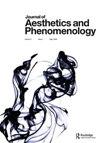The Strife of World and Earth as an Articulation of the Ontological Difference
IF 0.2
0 PHILOSOPHY
引用次数: 0
Abstract
ABSTRACT In a passage from the addendum to “The Origin of the Work of Art” often ignored in the secondary literature, Heidegger expands on how art institutes the unconcealment of the truth of Being with reference to the ontological difference—the difference between Being and beings which cannot rely on the comparison of predicates for clarification. The relationship between art and the ontological difference is not immediately obvious and lacks further explication in Heidegger’s other texts. This paper argues that there are two fundamental elements to the ontological difference that Heidegger focuses on that can be used to elucidate art as a strife of world and earth: “the Nothing” [das Nichts] outlined in “What is Metaphysics?” (1929) and world-projection described in The Fundamental Concepts of Metaphysics (1929–30). Understanding these two elements of the ontological difference (world-projection and the Nothing) as present together in the event of unconcealment (aletheia) thereby clarifies for the notorious concepts of earth, world, strife, and rift (Riß) that characterize the work of art. Recourse to the ontological difference as an explanatory mechanism for conceptualising Heidegger’s philosophy of art is a useful way of avoiding common issues in the prevailing literature that will be laid out below.天地之争是本体论差异的一种表达
摘要:在《艺术作品的起源》的附录中,海德格尔在一段经常被次要文献所忽视的段落中,阐述了艺术如何通过本体论的差异——即不能依靠谓词的比较来澄清的存在与存在之间的差异——来实现存在真理的揭露。艺术与本体论差异之间的关系并不明显,在海德格尔的其他文本中也缺乏进一步的解释。本文认为,海德格尔所关注的本体论差异有两个基本要素,可以用来阐明艺术作为世界和地球的冲突:“什么是形而上学?”(1929)和《形而上学的基本概念》(1929 - 30)中描述的世界投射。理解本体论差异的这两个要素(世界投射和虚无)在不隐藏(真理)的情况下一起出现,从而澄清了以艺术作品为特征的臭名昭著的地球、世界、冲突和裂痕(Riß)的概念。借助本体论差异作为一种解释机制来概念化海德格尔的艺术哲学,是一种有用的方法,可以避免在下面列出的主流文学中的共同问题。关键词:海德格尔本体差异世界-预测世界与地球披露声明作者未报告潜在的利益冲突。注1:海德格尔,“艺术作品的起源”(下称“OWA”),见《偏僻之路》,55.2同上,52.3波尔特,“意义、过剩与事件”,32.4同上,5威伊,《海德格尔论自我隐藏》,41.6同上,7海德格尔,《基本问题》,78。重点补充道。在《康德与形而上学问题》(157)中,海德格尔问道:“因此,对于每一个存在来说,‘有’有‘什么存在’和‘那存在’,有‘本质’和‘存在’,有‘可能性’和‘现实性’。“Being”在这里的意思是一样的吗?如果不是,那么在什么存在和那个存在中的存在是怎样分裂的呢?威斯本人对本体论差异的理解有时是有问题的。她在第43页写道"本体论的差异并不是说一个实体的存在与那个实体是不同的"然而,这正是海德格尔想要引起人们注意的:一个实体和它的存在方式不是分离的,它们彼此依赖,但它们不能被说成是可通约的。《论根据的本质》(1929)认为,“在其存在中的存在和存在的存在……在本质上属于一起,基于它们与存在和存在之间的区别(本体论差异)的关系。”9同上,38.10同上,27.11见芬斯克:《海德格尔:思想与历史性》,142;贝克曼,《复杂的存在》,151。同样,诺埃尔·史密斯(Nowell Smith)在《声音/沉默》(sounds /Silence, 42)中断言,在这里强调统一性是至关重要的:“进入现象世界不仅需要这种差异牵引,还需要开放一个相互属于的空间,通过这个空间,生物在开放中‘连接’在一起。”13 Radloff,《海德格尔与国家社会主义问题》,327.14见Withy (Citation2022)和Cassati (Citation2021)对本体论差异的不同解释的讨论海德格尔,《基本问题》,17.16同上,78.17同上,18同上,19同上,70.20同上21海德格尔,《基本概念》,362.22同上,364.23同上,363.24同上,25同上,364.26同上27海德格尔,OWA, 23.28同上,16.29同上,14.30同上,26.31同上,27.32同上,33艾伦,省略句,88.34海德格尔,“什么是形而上学?”《基础写作》,95.35同上,102.36海德格尔,《路径标记》中“论基础的本质”,97.37海德格尔,《路径标记》中“论真理的本质”,151.38同上,153.39海德格尔,OWA, 30.40同上,26.41海德格尔,“什么是形而上学?”汤姆逊,海德格尔,《艺术,后现代》,1998。Cooper (Citation2020), 195也采用了这一立场:“对于海德格尔来说,这是可能的,因为图片背景的动态黑暗,形状似乎从中浮现,他将其与术语“无”联系在一起”。43海德格尔:《逻辑的形而上学基础》,第210页。海德格尔还描述了焦虑中的世界的表象作为存在和时间中的无的表象之间的一致性,232:“因此,如果‘无’——也就是世界本身——表现为人们焦虑面对的那个东西,这意味着世界中的存在本身就是焦虑面对的那个东西。44海德格尔,OWA, 20.45同上,20-21.46同上,24.47同上,25.48同上,49同上50海德格尔,《形而上学导论》,29.51海德格尔,OWA, 31.52同上,53同上,54同上,31.55同上,56同上,32.57同上,44.58同上,40.59同上,36。作者简介:米歇尔·撒切尔是一位博士。
本文章由计算机程序翻译,如有差异,请以英文原文为准。
求助全文
约1分钟内获得全文
求助全文

 求助内容:
求助内容: 应助结果提醒方式:
应助结果提醒方式:


